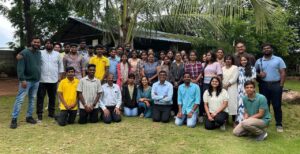The overuse of insecticides has come under increasing scientific and media scrutiny. Last year the journal Biological Conservation published a bombshell study suggesting 40% of all insect species are in decline with many en route to extinction within decades. Habitat loss by conversion to intensive agriculture, the study claimed, “is the main driver.”
Given that the dimensions of this problem are financial as well as ecological, there are dozens of agtech startups seeking ways to mitigate it — ranging from pheromone developers, to pioneers of novel “sterile insect techniques,” to designers of bug-detecting robots or drones capable of prescribing a more judicious pest control.
Spotta is one such startup, based in Cambridge, UK. The team wants to enable a lighter use of insecticides by building networks of accurate real-time insect detectors. With its initial focus on low-power, portable, IoT sensors for bug spotting in the hospitality industry, the team has just secured $1.18 million in seed funding with plans to deploy similar sensors in agriculture and forestry as well.
Representatives of Cambridge Angels and REMUS, a Boston-based VC firm, will join Spotta’s board as part of this investment deal. Other major investors include Martlet Capital, Wren Capital, and the Angel CoFund.
In a phone call with AFN, Spotta CEO Robert Fryers outlined how hospitality had been an early springboard for his company, as the range of insects a device needs to detect is lower and the design of the sensor had to be less robust; he said his team were working on AI-powered detection of a widening range of agricultural species invasive to specific crops or trees, and were adapting the designs accordingly to maintain lasting sentience and connectivity in glasshouses or outdoors.
“There’s a big gap in insect monitoring,” believes Fryers, describing what he sees as a reactive situation on many farms involving expensive, error-prone and infrequent manual inspections, where there’s usually “someone with a clipboard counting bugs on a plastic trap,” and the response to infestations is often akin to a disproportionate carpet bombing to be on the safe side. “The timing is crucial,” he said, as an alert just a few days earlier would mean a lot less pesticide and yield loss.
A sense of competition
In a statement describing the deal, Krishna K. Gupta of REMUS (and now a board member of Spotta) anticipated a US expansion for Spotta’s “multidimenional technical expertise.” Gupta described the pest control space as “relatively untouched by digital innovation.”
But with his claim of “relatively untouched,” Gupta has raised a few objections among agronomists. Allan Fetters of AGceleration, an agri-consultancy, flatly disagrees. He reckons a company like Spotta will need to play catch-up. “There are several companies currently producing remote pest monitoring solutions,” he wrote to AFN. “Spotta‘s technology is behind in this market.” Fetter said he had worked with several current post monitoring options out there, including those designed by Semios, DTN, Metos, Trapview, CropSafe, and FarmSense.
Spotted any pest control sensors? Let us know by dropping an email to [email protected]




